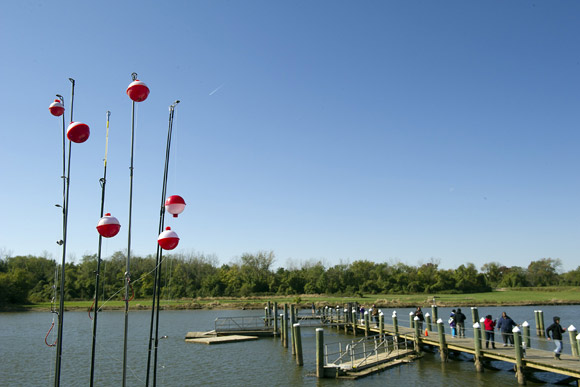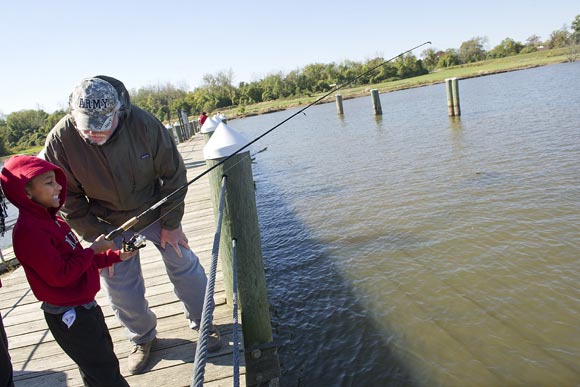On a bright and blustery Saturday a small group of would-be fishermen gathered along the riverbank. Kids and parents armed with fishing poles and bait set out to catch some fish and have some fun. As it turns out, the fun was part of a larger effort to discover more about the toxins that fish from the river carry.
The Anacostia Watershed Society (AWS) partnered with the University of Maryland, the Anacostia Community Museum, and the Maryland-National Capital Park and Planning Commission to host a
recreational fishing day at the Bladensberg Waterfront Park in Bladensberg, Md. in an effort to study the toxins found in Anacostia fish, as well as educate the public on present toxins found in the river.
The event on Oct. 26 provided fishers with free bait and pole rentals, as well as a $10 gift card in exchange for their catches.
Despite several advisories against consuming fish from the river, a 2012
report spearheaded by the AWS shows that more than 17,000 people are still eating fish, particularly catfish, from the Anacostia.
The event was an opportunity for researchers from the university to collect tissue samples from the catfish, in a project known as Community-Based Assessment of Exposure to Substances in the Anacostia River Region (Project CAESARR), which will further research into the specific toxins the catfish carry.
“We thought it made sense to try and understand the contaminants in the river, who is affected, and how to reduce exposure,” says Dr. Sacoby Wilson, assistant professor at of environmental health at the University of Maryland.

Despite the cold, the free event drew lots of families, but they caught only a handful of fish; most of the fish that were collected for sampling were caught with a net.
Still, it was only one of many outreach efforts that will be aimed at educating the public about the dangers of consuming fish from the river; AWS is planning another fishing event in the spring.
The AWS has found that nearly 22 percent of anglers were unaware of the health risks associated with eating fish from the Anacostia. Yet the dangers are very real.
Two-thirds of the catfish from the Anacostia River have cancerous lesions or sores, says Dottie Younger, program specialist for AWS. They also contain chemicals in their bodies that can cause cancer in humans.
Aside from cancer, exposure to the toxins in the river can lead to tremendous effects such as a compromised immune system and diarrhea, Dr. Wilson says.
Preventative alternatives
“This is part of a larger effort to understand who is fishing on the river,” Younger says.
In the past the advisories weren't as effective, often because they weren't targeted at the right people. For example, AWS has found that about 26 percent of anglers that fish on the Anacostia speak a language other than English and the majority of anglers are unlicensed.
By figuring out exactly who's doing the fishing, AWS and the University of Maryland hope to create and tailor its initiatives to ensure that the toxicity message reaches its intended audience.
Regardless of the advisories, many of anglers still depend on the fish from the Anacostia to feed their families and communities.

“What our studies showed is that really, the best message is to not eat fish out of the river, but that's not practical without giving them alternative food sources,” Younger says.
While the catfish of the Anacostia are completely unsafe to eat, on Saturday AWS educated attendees on different baits they could use to catch other, less toxic fish, she says.
Currently that's the only feasible alternative, Dr Wilson says. But there are plans to try and create an aquaculture farm, a fish exchange, as well as educating people on safer places along the river to fish, he says.
Long term, the best solution points to cleaning up the Anacostia altogether.
“I love supporting the AWS and all the educational programs they do," says Rebecca Roberts of Hyattsville, Md., "and we're really, really excited to have the Anacostia getting cleaned up.”